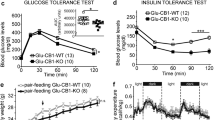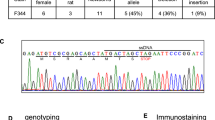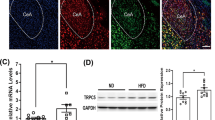Abstract
OBJECTIVE: There is growing evidence for an implication of the CB1 receptor subtype of the endocannabinoid system in the regulation of eating and fat deposition. To further define the physiological role of these receptors in the control of energy balance, we characterized the phenotype of CB1 receptor knockout (CB1−/−) mice maintained on an obesity-prone regimen or on a standard chow.
DESIGN: CB1−/− male mice were compared to wild-type animals (CB1+/+ male mice) in two feeding paradigms: (1) with a standard laboratory regimen (3.5 kcal/g, 14.5% of energy as fat) and (2) on a free-choice paradigm consisting of offering both the standard laboratory chow and a high-fat diet (HFD) (4.9 kcal/g, 49% of energy as fat).
RESULTS: When maintained on the standard diet, CB1−/− mice are lean. At the age of 20 weeks, their body weight and adiposity are, respectively, 24 and 60% lower than that of CB1+/+ mice. They are slightly hypophagic, but when expressed as percent of body weight, their relative energy intake is similar to that of the wild-type animals. Furthermore, inactivation of CB1 receptors reduces plasma insulin and leptin levels, and enhances the response to intracerebroventricular leptin injection. The free-choice paradigm shows that the preference for a high-fat highly palatable chow is slightly delayed in onset but maintained in CB1−/− mice. However, loading CB1−/− mice with this obesity-prone diet does not result in development of obesity. Knockout mice do not display hyperphagia or reduction of their relative energy intake in contrast to CB1+/+ mice, and their feeding efficiency remains low. These data suggest an improved energetic metabolism with the high-fat regimen. Furthermore, the insulin resistance normally occurring in HFD-fed mice is not present in CB1−/− mice.
CONCLUSION: These results provide evidence that the stimulation of CB1 receptors is a key component in the development of diet-induced obesity, and that these receptors and their endogenous ligands are implicated not only in feeding control but also in peripheral metabolic regulations. The lack of effect of SR141716, a selective CB1 receptor antagonist, in CB1−/− mice further supports this hypothesis, as this compound was previously shown to display potent anti-obesity properties in diet-induced obese C57BL/6 mice.
This is a preview of subscription content, access via your institution
Access options
Subscribe to this journal
Receive 12 print issues and online access
$259.00 per year
only $21.58 per issue
Buy this article
- Purchase on Springer Link
- Instant access to full article PDF
Prices may be subject to local taxes which are calculated during checkout






Similar content being viewed by others
References
Walker JM, Hohmann AG, Martin WJ, Strangman NM, Huang SM, Tsou K . The neurobiology of cannabinoid analgesia. Life Sci 1999; 65: 665–673.
Martin M, Ledent C, Parmentier M, Maldonado R, Valverde O . Involvement of CB1 cannabinoid receptors in emotional behaviour. Psychopharmacology 2002; 159: 379–387.
Terranova JP, Michaud JC, Le Fur G, Soubrié P . Inhibition of long-term potentiation in rat hippocampal slices anandamide and WIN55212-2: reversal by SR141716A, a selective antagonist of CB1 cannabinoid receptors. Naunyn Schmiedebergs Arch Pharmacol 1995; 352: 576–579.
Kirkham TC, Williams CM . Endogenous cannabinoids and appetite. Nutr Res Rev 2001; 14: 65–86.
Koch JE . 9-THC stimulates food intake in Lewis rats. Effects on chow, high-fat and sweet high-fat diets. Pharmacol Biochem Behav 2001; 68: 539–543.
Williams CM, Kirkham TC . Observational analysis of feeding induced by Δ9-THC and anandamide. Physiol Behav 2002; 76: 241–250.
Williams CM, Kirkham TC . Anandamide induces overeating: mediation by central cannabinoid (CB1) receptors. Psychopharmacology 1999; 143: 315–317.
Kirkham TC, Williams CM, Fezza F, Di Marzo V . Endocannabinoid levels in rat limbic forebrain and hypothalamus in relation to fasting, feeding and satiation: stimulation of eating by 2-arachidonoyl glycerol. Br J Pharmacol 2002; 136: 550–557.
Rinaldi-Carmona M, Barth F, Héaulme M, Shire D, Calandra B, Congy C, Martinez S, Maruani J, Néliat G, Caput D, Ferrara P, Soubrié P, Brelière JC, Le Fur G . SR141716A, a potent and selective antagonist of the brain cannabinoid receptor. FEBS Lett 1994; 350: 240–244.
Williams CM, Kirkham TC . Reversal of Δ9-THC hyperphagia by SR141716 and naloxone but not dexfenfluramine. Pharmacol Biochem Behav 2002; 71: 341–348.
Colombo G, Agabio R, Diaz G . Appetite suppression and weight loss after the cannabinoid antagonist SR141716. Life Sci 1998; 63: 113–117.
Rowland NE, Mukherjee M, Robertson K . Effects of the cannabinoid receptor antagonist SR141716, alone and in combination with dexfenfluramine or naloxone, on food intake in rats. Psychopharmacology 2001; 159: 111–116.
Arnone M, Jung M, Keane PE, Maffrand JP, Soubrié P . The CB1 cannabinoid receptor antagonist SR141716 reduces sucrose intake and fat diet preference in lean and obese rats. Int J Obes Relat Metab Disord 1999; 23 (Suppl 5): S63.
Simiand J, Keane M, Keane PE, Soubrié P . SR141716, a CB1 cannabinoid receptor antagonist, selectively reduces sweet food intake in marmoset. Behav Pharmacol 1998; 9: 179–181.
Ravinet Trillou C, Arnone M, Delgorge C, Gonalons N, Keane P, Maffrand JP, Soubrié P . Anti-obesity effect of SR141716, a CB1 receptor antagonist, in diet-induced obese mice. Am J Physiol Regul Integr Comp Physiol 2003; 284: R345–R353.
Di Marzo V, Goparaju SK, Wang L, Liu J, Bátkai S, Járai Z, Fezza F, Miuras GI, Palmiter RD, Sugiura T, Kunos G . Leptin-regulated endocannabinoids are involved in maintaining food intake. Nature 2001; 410: 822–825.
Hildebrandt AL, Kelly-Sullivan DM, Black SC . Antiobesity effects of chronic cannabinoid CB1 receptor antagonist treatment in diet-induced obese mice. Eur J Pharmacol 2003; 462 (1–3): 125–132.
Cota D, Giovanni M, Tschöp M, Grübler Y, Flachskamm C, Schubert M, Auer D, Yassouridis A, Thöne-Reineke C, Ortmann S, Tomessoni F, Cervino C, Nisoli E, Linthorst AG, Pasquali R, Lutz B, Stella GK, Pagotto U . The endogenous cannabinoid system affects energy balance via central orexigenic drive and peripheral lipogenesis. J Clin Invest 2003; 112: 423–431.
Robbe D, Kopf M, Remaury A, Bockaert J, Manzoni OJ . Endogenous cannabinoids mediate long-term synaptic depression in the nucleus accumbens. Proc Natl Acad Sci 2002; 99: 8384–8388.
Dickinson K, North TJ, Telford G, Smith S, Brammer R, Jones RB, Heal DJ . Determination of body composition in conscious adult female Wistar utilising total body electrical conductivity. Physiol Behav 2001; 74: 425–433.
Vickers SP, Webster LJ, Wyatt A, Dourish CT, Kennett GA . Preferential effects of the cannabinoid CB1 receptor antagonist, SR141716, on food intake and body weight gain of obese (fa/fa) compared to lean Zucker rats. Psychopharmacology 2003; 167: 103–111.
West DB, Boozer CN, Moody DL, Atkinson RL . Dietary obesity in nine inbred mouse strains. Am J Physiol Regul Integr Comp Physiol 1992; 262: R1025–R1032.
Kirkham TC, Williams CM . The cannabinoid receptor antagonist SR141716 fails to suppress sucrose sham feeding. J Psychopharmacol 1998; 12 (Suppl A): 37.
Gallate JE, McGregor IS . The motivation for beer in rats: effects of ritanserin, naloxone and SR141716. Psychopharmacology 1999; 142: 302–308.
Gallate JE, Saharov T, Mallet PE, McGregor IS . Increase motivation for beer in rats following administration of a cannabinoid CB1 receptor agonist. Eur J Pharmacol 1999; 370: 233–240.
Bensaid M, Gary-Bobo M, Esclangon A, Maffrand JP, Le Fur G, Oury-Donat F, Soubrié P . The cannabinoid CB1 receptor antagonist SR141716 increases Acrp30 mRNA expression in adipose tissue of obese fa/fa rats and in cultured adipocyte cells. Mol Pharmacol 2003; 63: 908–914.
Fruebis J, Tsao TS, Javorschi S, Ebbets-Reed D, Erickson MR, Yen FT, Bihain BE, Lodish HF . Proteolytic cleavage product of 30-kDa adipocyte complement-related protein increases fatty acid oxidation in muscle and causes weight loss in mice. Proc Natl Acad Sci 2001; 98: 2005–2010.
Shimada M, Tritos NA, Lowell BB, Flier JS, Maratos-Flier E . Mice laking melanin-concentrating hormone are hypophagic and lean. Nature 1998; 396: 670–674.
Erickson JC, Clegg KE, Palmiter RD . Sensitivity to leptin and susceptibility to seizures of mice lacking neuropeptide Y. Nature 1996; 381: 415–418.
Hollopeter G, Erickson JC, Seeley RJ, Marsh DJ, Palmiter RD . Response of neuropeptide Y-deficient mice to feeding effectors. Regulat Pept 1998; 75–76: 383–389.
Kim JY, Nolte LA, Hansen PA, Han DH, Ferguson K, Thompson PA, Holloszy JO . High-fat diet-induced muscle insulin resistance: relationship to visceral fat mass. Am J Physiol Regul Integr Comp Physiol 2000; 279: R2057–R2065.
Lemonnier D, Suquet JP, Aubert R, De Gasquet P, Pequignot E . Metabolism of the mouse made obese by a high-fat diet. Diabetes Metab 1975; 1: 77–85.
Sindelka G, Skrha J, Prazny M, Haas T . Association of obesity, diabetes, serum lipids and blood pressure regulates insulin action. Physiol Res 2002; 51: 85–91.
Acknowledgements
We thank N Boussac for help with the statistical analyses and C Dumontet for preparation of the manuscript.
Author information
Authors and Affiliations
Corresponding author
Rights and permissions
About this article
Cite this article
Ravinet Trillou, C., Delgorge, C., Menet, C. et al. CB1 cannabinoid receptor knockout in mice leads to leanness, resistance to diet-induced obesity and enhanced leptin sensitivity. Int J Obes 28, 640–648 (2004). https://doi.org/10.1038/sj.ijo.0802583
Received:
Revised:
Accepted:
Published:
Issue Date:
DOI: https://doi.org/10.1038/sj.ijo.0802583
Keywords
This article is cited by
-
The CB1 cannabinoid receptor regulates autophagy in the tibialis anterior skeletal muscle in mice
Biological Research (2023)
-
Obesity risk is associated with altered cerebral glucose metabolism and decreased μ-opioid and CB1 receptor availability
International Journal of Obesity (2022)
-
The effects of cannabis and cannabinoids on the endocrine system
Reviews in Endocrine and Metabolic Disorders (2022)
-
Association of CNR1 and INSIG2 polymorphisms with antipsychotics-induced weight gain: a prospective nested case–control study
Scientific Reports (2021)
-
Cannabinoid CB1 receptor in dorsal telencephalic glutamatergic neurons drives overconsumption of palatable food and obesity
Neuropsychopharmacology (2021)



